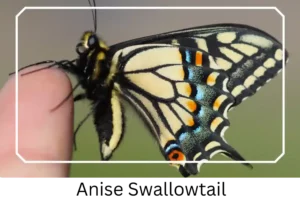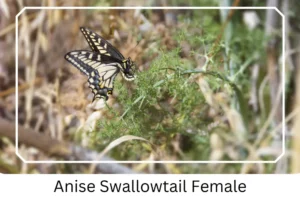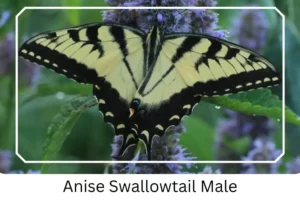Anise Swallowtail (Papilio zelicaon)
The Anise Swallowtail (Papilio zelicaon) is a captivating species of butterfly that graces North America with its vibrant presence. Known for its striking yellow or beige coloration and intricately patterned wings, this swallowtail butterfly is not only a visual delight but also an intriguing subject for both amateur naturalists and professional entomologists. Classified as Secure (‘G5’) by NatureServe, the Anise Swallowtail enjoys a robust population across its widespread habitat, making it a common yet remarkable sight in various landscapes.
Scientific Classification
- Family: Papilionidae
- Genus: Papilio
- Scientific Name: Papilio zelicaon
Overview
This butterfly species thrives in a diverse range of environments from the entire western parts of North America. It exhibits a unique life cycle that encompasses remarkable transformations through its larva, pupa, and adult stages, each fascinating in its own right. The Anise Swallowtail’s ability to adapt and flourish in both natural and human-altered environments underscores its resilience and the role it plays in local ecosystems.
Description and Identification
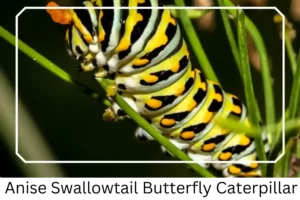
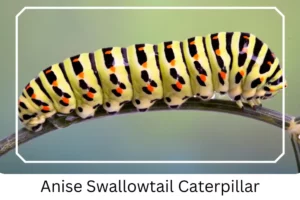 Caterpillar
Caterpillar
The journey of the Anise Swallowtail begins as a caterpillar, which goes through five instars before reaching maturity. At full size, the caterpillar boasts a predominantly green body adorned with black, orange, and light blue markings. Its diet consists of leaves from specific host plants, and when threatened, it emits a foul-smelling orange fluid as a defense mechanism. The caterpillar can reach a length of up to 5 cm, showcasing nature’s intricate design and adaptability.
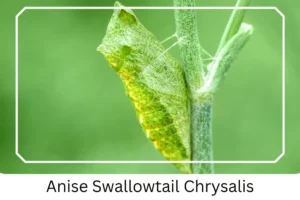 Pupa
Pupa
Transitioning to the pupa stage, the Anise Swallowtail Chrysalis exhibits a light brown to green coloration, blending seamlessly with its surroundings by mimicking a small branch. This camouflage is further secured by durable silk, anchoring the pupa to the host plant and ensuring a safe metamorphosis into its adult form.
Adult Butterfly
Sexual Dimorphism: In the adult stage, there are no noticeable differences between males and females, allowing for a uniform appreciation of their beauty.
Color and Appearance: With wings unfurled, the dorsal surface of the forewings shines in a primary yellow hue, edged with black bands that echo on the hind wings. The secondary wings feature yellowish-orange to red eyespots near the tails, each with a black pupil, and a predominantly yellow anal cell. The ventral side reveals a fainter mimic of the dorsal patterns when the wings are closed, maintaining the butterfly’s allure from every angle.
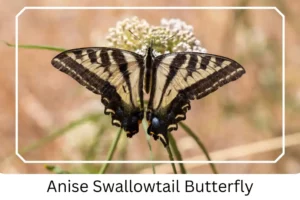
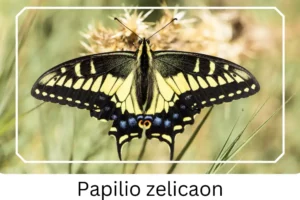 Average Wingspan: The Anise Swallowtail boasts an average wingspan ranging from 52 to 80 mm (2.0 to 3.1 inches), allowing for slow, yet erratic flight patterns that captivate onlookers.
Average Wingspan: The Anise Swallowtail boasts an average wingspan ranging from 52 to 80 mm (2.0 to 3.1 inches), allowing for slow, yet erratic flight patterns that captivate onlookers.
Flight Pattern: Characterized by its slow, yet erratic flight, the Anise Swallowtail displays a unique aerial dance that is both mesmerizing and distinctive among butterfly species.
Eggs
The reproductive cycle of the Anise Swallowtail begins with the laying of small, round, and yellow eggs. Deposited singularly, these eggs are the genesis of the next generation, continuing the cycle of life for this remarkable species.
Quick Facts | |
| Distribution | Found across the entire western parts of North America. |
| Habitat | Inhabits bare hills, mountains, gardens, vacant fields, lots, and roadsides. |
| Lifespan of Adults | Ranges from 6 to 14 days. |
| Host Plants | Prefers plants from the carrot, Apiaceae, parsley, and citrus families. |
| Adult Diet | Remains largely unspecified, highlighting an area for further study. |
How to Identify Anise Swallowtail?
Identifying the Anise Swallowtail can be an enjoyable and educational experience, given its distinct features. Look for the bright yellow or beige wings with black bands along the edges, a hallmark of the species. The presence of yellowish-orange to red eyespots near the tails of the secondary wings is another key identifier. These butterflies are often found in open spaces such as gardens, fields, and along roadsides, where they flutter in their unique, erratic flight pattern. Observing the caterpillar’s green body with colorful markings or spotting the unique chrysalis can also provide clues to the presence of the Anise Swallowtail.
Did You Know?
- The Anise Swallowtail is frequently confused with the Tiger Swallowtail; however, it is notably smaller and lacks the vertical black striping pattern of its counterpart.
- This butterfly species plays a crucial role in pollination, contributing to the health of their habitats and the survival of various plant species.
Conclusion
The Anise Swallowtail butterfly is a testament to the beauty and complexity of nature. From its early days as a caterpillar to its breathtaking adult form, each stage of its life cycle offers something unique to observe and appreciate. As a subject of study and admiration, the Anise Swallowtail not only enriches our understanding of the natural world but also reminds us of the interconnectedness of all living things.

